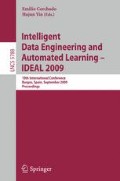Abstract
Security of sensor networks is a complicated task, mostly due to the limited resources of sensor units. Encryption and authentication are useless if an attacker has entered the system. Thus, a second line of defense known as Intrusion Detection must be added in order to detect and eliminate attacks. In the recent past, various solutions for detecting intrusions have been proposed. Most of them are able to detect only a limited number of attacks. The solutions that deploy machine learning techniques exhibit higher level of flexibility and adaptability. Yet, these techniques consume significant power and computational resources. In this work we propose to implement unsupervised algorithms (genetic algorithm and self-organized maps) for detecting intrusions using the energy-efficient SORU architecture. Separate detectors are further organized in a distributed system using the idea of immune system organization. Our solution offers many benefits: ability to detect unknown attacks, high adaptability and energy efficiency. First testing results obtained in real environment demonstrate its high potential.
Access this chapter
Tax calculation will be finalised at checkout
Purchases are for personal use only
Preview
Unable to display preview. Download preview PDF.
References
Rieck, K., Laskov, P.: Linear Time Computation of Similarity for Sequential Data. Journal of Machine Learning Research 9, 23–48 (2008)
Moya, J.M., Rodríguez, J., Martín, J., Vallejo, J.C., Malagón, P., Araujo, A., de Goyeneche, J.M., Rubio, A., Romero, E., Villanueva, D., Nieto-Taladriz, O., Lopez Barrio, C.A.: A Low Power Reconfigurable Architecture for Adaptable Embedded Systems. In: WRC (2009)
Bankovic, Z., Moya, J.M., Araujo, A., de Goyeneche, J.M.: Anomaly Detection in Wireless Sensor Networks using Reconfigurable SORU Processor and Self-Organizing Maps. JCRA (to appear, 2009)
Perrig, A., Stankovic, J., Wagner, D.: Security in Wireless Sensor Networks. Communications of the ACM 47(6), 53–57 (2004)
Bar El, H.: Introduction to Side Channel Attacks. White Paper by Discretix Technologies
Ganeriwal, S., Srivastava, M.B.: Reputation-based Framework for High Integrity Sensor Networks. In: SASN, pp. 66–77 (2004)
Wagner, D.: Resilient Aggregation in Sensor Networks. In: SASN 2004 – 2004 ACM Workshop on Security of Ad Hoc and Sensor Networks, pp. 78–87 (2004)
Ganeriwal, S., Capkun, S., Han, C., Srivastava, M.B.: Secure Time Synchronization Service for Sensor Networks. In: Workshop on Wireless Security, pp. 97–106 (2005)
Roman, R., Zhou, J., López, J.: Applying Intrusion Detection Systems to Wireless Sensor Networks. In: IEEE Consumer Communications & Networking Conference, CCNC 2006 (2006)
Krontiris, I., Giannetsos, T., Dimitriou, T.: LIDeA: A Distributed Lightweight Intrusion Detection Architecture for Sensor Networks. In: SECURECOMM (2008)
Wallenta, C., Kim, J., Bentley, P.J., Hailes, S.: Detecting Interest Cache Poisoning in Sensor Networks using an Artificial Immune Algorithm. Appl. Intell (2008)
Yu, Z., Tsai, J.: A Framework of Machine Learning Based Intrusion Detection for Wireless Sensor Networks. In: SUTC, pp. 272–279 (2008)
SOM Algorithm, http://www.ai-junkie.comñ/ann/som/som2.html
Muñoz, A., Muruzábal, J.: Self-Organizing Maps for Outlier Detection. Neurocomputing 18(1-3), 33–60 (1998)
Newsome, J., Shi, E., Song, D., Perrig, A.: The Sybil Attack in Sensor Networks: Analysis & Defenses. In: IPSN, pp. 259–268 (2004)
Ganeriwal, S., Balzano, L.K., Srivastava, M.B.: Reputation-based Framework for High Integrity Sensor Networks. ACM Trans. Sens. Netw. (TOSN) 4(3) (2008)
Cluster Validity Indices, http://www.biomedcentral.com/content/supplementary/1471-2105-9-90-S2.pdf
Author information
Authors and Affiliations
Editor information
Editors and Affiliations
Rights and permissions
Copyright information
© 2009 Springer-Verlag Berlin Heidelberg
About this paper
Cite this paper
Banković, Z., Moya, J.M., Araujo, Á., de Goyeneche, JM. (2009). Intrusion Detection in Sensor Networks Using Clustering and Immune Systems. In: Corchado, E., Yin, H. (eds) Intelligent Data Engineering and Automated Learning - IDEAL 2009. IDEAL 2009. Lecture Notes in Computer Science, vol 5788. Springer, Berlin, Heidelberg. https://doi.org/10.1007/978-3-642-04394-9_50
Download citation
DOI: https://doi.org/10.1007/978-3-642-04394-9_50
Publisher Name: Springer, Berlin, Heidelberg
Print ISBN: 978-3-642-04393-2
Online ISBN: 978-3-642-04394-9
eBook Packages: Computer ScienceComputer Science (R0)

